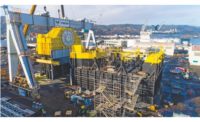There was a time in which Hawaii’s geographical latitude placed its coral reefs outside the zone of the type of climate-change-induced reef degradation happening in other parts of the world. That changed in 2015, says Greg Asner, director of Arizona State University’s Center for Global Discovery and Conservation Science, whose Hawaii-based team had been mapping and monitoring the state’s reefs for about twelve years at that point. “We had a massive heat wave that the scientific records showed we had not experienced in at least a century, if ever,” he added, which led to massive coral loss.
But climate change wasn’t the sole factor leading to dwindling reefs. Pollution, particularly urban and wastewater runoff, had been contributing to reef decline in the state before then, but the “compounding effect of coral pollution with heat” provided a “one-two punch,” says Asner.
The researcher and the university, in a partnership that includes Hawaii’s Division of Aquatic Resources and a number of community and Native Hawaiian organizations, are now applying the insights gleaned from more than two decades of monitoring to its next phase, dubbed ʻĀkoʻakoʻa. Announced in June with a $25-million grant, the initiative will initially focus on restoring 120 miles of coral reef on the west side of Hawaii island as the partnership constructs a complementary coral nursery and research facility in Kailua-Kona that, when complete, will be the largest in the world, according to ASU. Targeted for completion this fall, “it is integrating a huge range of activities that address all of the things we figured out over the last 20 years, all at one time,” says Asner.

The research facility and nursery will study and propagate coral to restore degraded reefs, which help protect coastlines and prevent flooding by absorbing wave energy.
Rendering courtesy ASU
Because of subsequent warming events since 2015 as well as the prospect of future events, the coral reef restoration goes beyond merely restoring reefs as they were. “We’re trying to work with nature to understand where [coral] has natural resistance or tolerance to the heat and then learn from that and enhance the ability of the reef to build off those corals that have natural resistance,” Asner adds. “That’s what our coral nursery is about.” Rows of tanks will faciliate coral research, thermal testing and propagation, backed by 40-ft-long water filtration systems.
The facility, being developed jointly by ASU and reforestation accelerator Terraformation, is located on a 1-acre site at the Natural Energy Laboratory of Hawaii Authority’s Hawaii Ocean Science and Technology Park, established by the state as a research and demonstration space for renewable energy and ocean technologies.
Part of the grant money will go toward a local reef workforce training program that will target multiple levels and skillsets, from high school to PhD level, with support intended to last through at least a decade.
For both the workforce development and restoration process itself, local community partnerships will be crucial. “The program’s model is, the indigenous knowledge is the foundation of everything. It is the actual compass for the program, and the science and the workforce and the governance are all in service to that cultural basis,” says Asner.
While the grant will focus on mitigating the climate-change-related dangers to coral reefs, monitoring has allowed the team to pinpoint specific sources of pollution that also threaten reefs. Among these are runoff from hotels and homes and wastewater treatment issues related to cesspools and septic tank leach fields.
Money from the Bipartisan Infrastructure Law is helping the state address its wastewater infrastructure, with $18 million announced in February via the Clean Water State Revolving Fund toward the conversion of the more than 80,000 cesspools in the state.
Cindi Punihaole, outreach coordinator for local partner Kohala Center, said in a statement, “When the land is healthy and clean, water flows to the shores, then our corals and fish will flourish. We strive for a world of balance and righteousness.”





